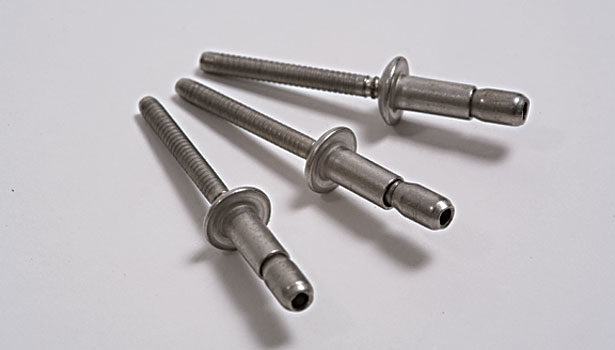Upon closer inspection, however, a riveted joint is every bit as complex as one assembled with threaded fasteners. And, a little design work up front can save engineers headaches later on the assembly line.
Orbital and Radial Forming
Orbital and radial forming are nonimpact cold-forming processes. They can form heads on loose rivets, as well as studs or bosses that are cast in one of the parts. In general, any malleable material up to Rockwell 35C can be formed with these processes. This includes most ferrous and nonferrous metals, stainless steel, zinc and aluminum die-cast material, and some sintered metal parts. These techniques can be even be used on engineering thermoplastics.
Because forming machines can be set to precise pressures, they can be used to secure assemblies containing Bakelite, ceramics, glass and other brittle materials.
When designing a joint to be assembled with orbital and radial forming, engineers should focus on how far the rivet shank or boss protrudes from the hole prior to forming, a dimension known as “stick-out.” As a rule of thumb, the stick-out should be 50 percent of the diameter of the boss or rivet. Thus, if the rivet is 8 millimeters in diameter, it should protrude from the hole by 4 millimeters.
“That varies, depending on the material,” explains Charles Rupprecht, vice president and general manager of Baltec Corp. “If you’re forming a more malleable material, such as brass or aluminum, you can get away with a higher stick-out. With harder materials, like stainless steel, you want to minimize stick-out, because the forming time can be long, and you want to minimize wear on the part itself and the riveting machine.”
Stick-out also varies depending on what is being formed. For example, a tubular rivet can have more stick-out than a solid rivet, since there’s less material to form.
Once the optimal stick-out has been established, engineers should ensure their parts supplier holds that dimension to within a few mils.
“We like to have the tolerances as tight as possible,” says Rupprecht. “If the parts are really out of whack, you may need to look at process control to ensure that you’re forming each rivet the same way.”
A riveter equipped with process control monitors key forming parameters, such as force, distance and time, and automatically compensates for variations. For example, if the stick-out is slightly more than expected, the riveter will apply pressure for more time until the desired head height is reached.
“Process control enables manufacturers to open up their tolerances a bit and save money on parts,” says Rupprecht.
The distance between rivets also varies with the application. Multiheading mechanisms can be mounted to a single riveting machine, so more than one rivet or boss can be headed at the same time. For light-duty applications, such as medical devices or electrical contacts, rivets can be spaced from 8 to 70 millimeters apart, center to center. For heavy-duty applications, such as auto parts, rivets can be spaced from 15 to 120 millimeters apart.
Whether assemblers use process control or not, they should strive to make the riveting process as short and simple as pos-sible. “The best thing is to let that riveting machine work within its specifications,” advises Rupprecht. “In other words, you want an average riveting time of 1.5 seconds.”
Rupprecht recalls one customer that was using a large pneumatic riveter to assemble master cylinders for truck brakes. The application called for forming a stainless steel solid rivet 12 millimeters in diameter.
“The stick-out was a little longer than it should have been, about 8 or 9 millimeters, and that riveter was sitting on that rivet for 6 or 7 seconds,” he says. “Our machine is heavy-duty enough to withstand that, but over the course of time, it’s going to require more maintenance.
“It would have been simple enough to drill out some material in the center of that rivet,” Rupprecht points out. “It would not have affected the final head form, and it would have helped the material flow better. The machine would work less. Cycle time would go from 6 seconds to 4 seconds, and maintenance costs would drop.”
Break-Stem Rivets
A break-stem rivet consists of a smooth, cylindrical body topped by a flared head. A mandrel with a bulbed head extends from the bottom of the rivet, through the body and out the center of the head.
To install a break-stem rivet, the fastener is inserted into the nosepiece of the setting tool. The fastener is then placed into a hole that has been drilled or punched in the parts.
When the tool is activated, jaws in the nosepiece grip the mandrel and pull it into the rivet body. The mandrel head expands the walls of the rivet radially to fill the hole. At the same time, the mandrel forms a load-bearing head at the end of the rivet, clamping the sheets together. When the tensile load on the mandrel exceeds the load necessary to deform the rivet body, the mandrel breaks off at a predetermined spot.
When designing a joint to be assembled with break-stem rivets, engineers first need to determine the strength requirements of the joint. What materials are being joined? What forces are acting on the joint? Will the rivets be used to assemble a sheet metal enclosure for a vending machine or the wind skirt for a semitrailer?
Nonstructural rivets can be used in low-strength applications, like the vending machine, that will not be subjected to much shear force. Structural rivets are needed for high-strength applications, like the wind skirt, that will be subjected to both shear and tensile loads. Structural rivets differ from nonstructural rivets in that part of the mandrel is retained inside the rivet body after break-off. That extra material gives structural rivets considerable resistance to shear loads.
“There’s not a lot of difference in tensile strength between most structural and nonstructural rivets, but there is a difference in shear strength,” explains Troy Pierce, senior design engineer with Alcoa Fastening Systems.
Engineers should choose a rivet of a large enough diameter to meet or exceed the shear and tensile strength requirements of the joint.
The rivet material is another concern. To prevent galvanic corrosion, the rivet should be made from a material that is compatible with the materials to be joined. For example, an aluminum or stainless steel rivet should be used to fasten aluminum sheets. However, if engineers choose an aluminum rivet, they may need a larger diameter fastener to get the same mechanical strength as a steel rivet. If the rivet and the materials to be joined are too widely separated on the galvanic chart, the fastener should be treated with a dielectric paint or other coating.
Once the strength and material requirements are known, engineers need to think about the rivet’s grip range—the total material thickness that can be joined by the rivet. Specifying the right grip range is particularly critical in structural applications, since the mandrel must break flush with the head, says Pierce.
The recommended hole size varies with the design of the rivet. Some rivets are designed to fill a wide hole, while others do not expand as much. A 0.25-inch nonstructural rivet might require a hole diameter of 0.261 to 0.272 inch, while a 0.25-inch structural rivet might need a hole diameter of 0.257 to 0.261 inch.
“That’s a lot different than hole tolerances for nuts and bolts,” says Pierce. “With rivets, you just want to be able to get the fastener into the hole. With a nut and bolt, [the hole can be larger] because they have wide bearing surfaces.
“If there’s a problem in the field [with a rivet], it’s usually related to the hole size.”
Pierce warns engineers that break-stem rivets do not have the same ability as threaded fasteners to draw sheets together during installation. This is usually not a problem, however, since the riveting tool pushes the parts together during installation. “With blind fasteners, gaps between the sheets are not good,” says Pierce. “You’ll get movement in the joint.”
As with orbital and radial forming, engineers should make sure to provide room for the riveting tool. Although the nosepiece can typically get as close as 0.5 inch to a sidewall, the riveting tool itself will get wider approximately 3 inches above the installation point.






